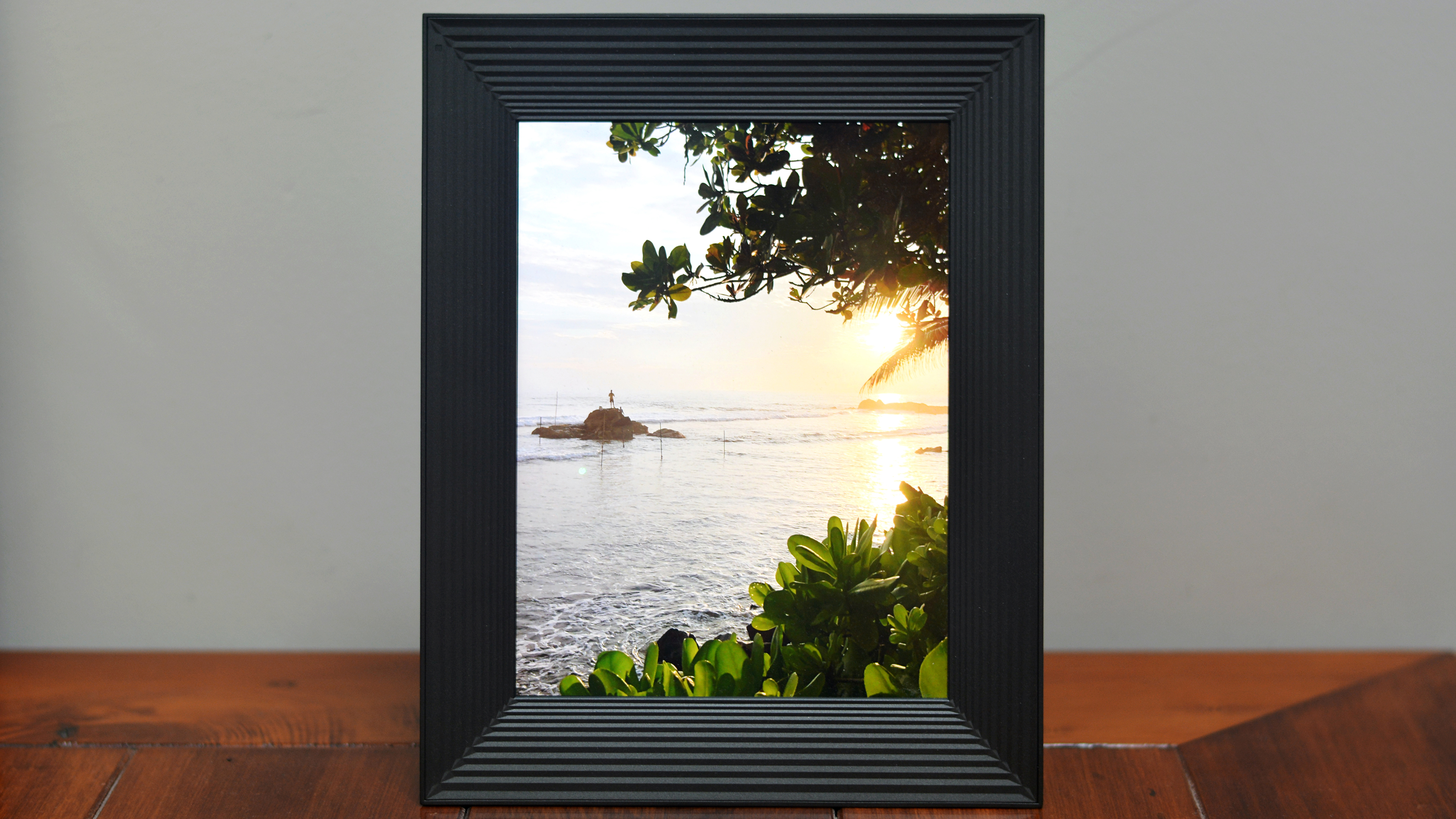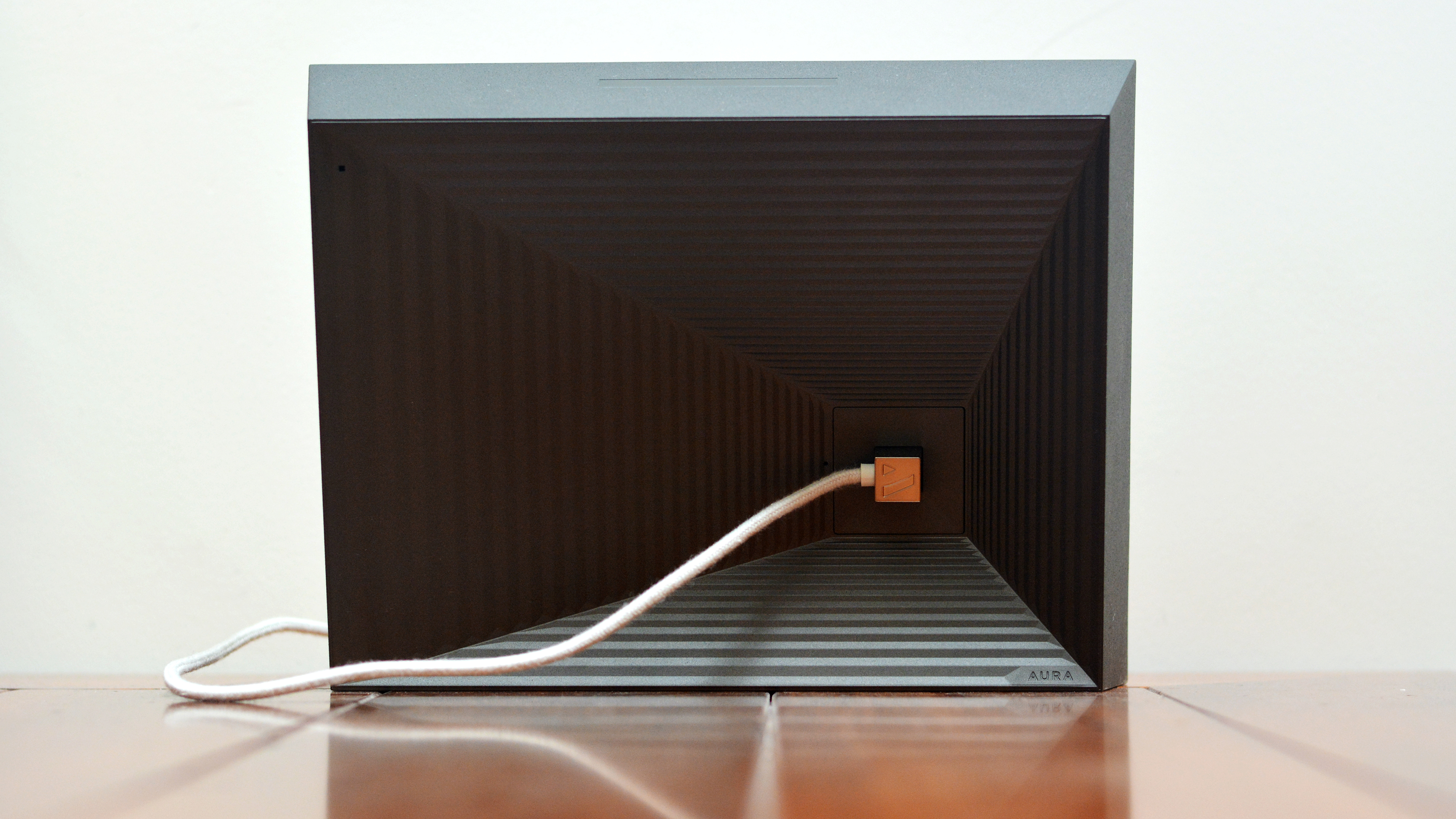TechRadar Verdict
Understated yet distinctive, the Aura Mason is a chic digital photo frame with a vivid display and a convenient freestanding design. Customization settings are limited, but an uncomplicated interface and integrated sharing options make it a neat and easy option that's currently our favorite digital photo frame.
Pros
- +
Distinctive minimalist design
- +
Sharp, vibrant screen
- +
Streamlined and seamless interface
Cons
- -
Display angle is fixed
- -
Limited settings to adjust
- -
Only ships with a US wall plug
Why you can trust TechRadar
Two-minute review
Traditional photo frames might ship in all shapes and sizes, but most of their digital equivalents tend to be generic bevelled rectangles. Not so the Aura Mason: styled as if it’s hewn from stone, this freestanding frame is a lesson in classy craftsmanship. Tiered bezels, a sculpted back and a premium textured finish all contribute to a design that’s understated yet subtly distinctive, distinguishing the Mason from the many matte black models on the market.
And the differences don’t end with the finish. The Mason is also unusual for its stand-free setup: portrait or landscape, it supports itself with nothing but the flat edge of its frame. Not only is this a neat solution that makes placement a cinch, but it’s also space-efficient. With no stand at the back, the footprint is really compact, meaning the Aura Mason can fit where even traditional frames might struggle to find room.
- These are the best digital photo frames you can buy right now

The downside of this design is that there’s no option to change the Mason’s tilt. While the fixed position matches the natural slant of most traditional photo frames, the freestanding setup does sacrifice some versatility compared to frames with adjustable legs. That said, viewing angles are exemplary: even at 80-degrees to the display, images appear clear and bright, so those looking to place the Mason on a higher shelf shouldn’t suffer from reduced visibility.
Image quality is also superlative. Digital photo frames ship in a range of display sizes but, at 9in, the Mason hits the sweet spot: it’s small enough to be subtle yet still offers plenty of space for photos to really shine. And shine they do, courtesy of a 1600 x 1200 resolution that’s up there with the best on the market. Detail is excellent and colors are vibrant but balanced, with a dash of added pop enhancing depth and countering the slightly reflective screen coating.

Adaptive brightness also helps in that regard, deftly adjusting to suit the ambient light levels (or switching off entirely in the dark), while automatic color correction seamlessly tweaks saturation to get the best out of your snaps.
It’s worth noting that this setting can’t be disabled, which seasoned image tweakers might find slightly overbearing, but it does consistently ensure that images appear vivid, while stopping a long way short of oversaturated. Framed by the well-proportioned bezel, the display delivers sharp, rich results and doesn’t lack for brightness.
Aura’s software is defined by simplicity and the setup experience is no exception. Download the Aura Frames app on a compatible smart device, connect the frame to your Wi-Fi network and you’ll be ready to add your photos. Select images from your device’s camera roll, iCloud or Google Photos library and, within a few seconds, they’ll appear as part of the Mason’s slideshow.
Sign up for breaking news, reviews, opinion, top tech deals, and more.
There’s also a web uploader, in case you have a batch of snaps on your hard drive that you’d like to share to the frame. All photos added are stored in Aura’s secure cloud and every frame comes with unlimited free storage.

Add an entire photo album via the app – which includes support for Google Smart Albums – and Aura’s software will filter its contents to remove duplicates and ignore blurry images. Likewise, it will also automatically position and crop images to suit the frame’s orientation – though you can manually adjust this if you want to. It’s an arrangement that reflects the frame’s broader approach to image management: the Mason is not designed for total control, but for straightforward ease of use.
All pictures that you pick form part of a single slideshow, with no option to create multiple playlists. You can select favorites in the app or by double-tapping one of the two responsive touch bars on the frame – which also allow you to swipe through images manually – but there’s otherwise no way of controlling how photos are sorted.
While specific pictures can be displayed by tapping ‘show now’, it generally feels simpler to surrender control to the Mason than to scroll through the app’s thumbnail grid. Which is no bad thing: with hundreds of images in the average slideshow, most people would set the display order to random anyway – and the Mason makes random that little bit slicker.

Some users will almost certainly want more authority over their frame. While sleep schedules and slideshow timings can be adjusted, for example, there’s no option to change transition effects. But the flip-side of the Mason’s pared-back approach is that its interface is uncluttered and intuitive, even for the uninitiated.
This is particularly handy if you’re planning to make use of the ability to invite family and friends to contribute to the frame from afar (without the need to be on the same Wi-Fi network). Provided you’re happy with a slightly hands-off attitude to organization, the Mason is a smart, chic and effective way to display your photos.
Should I buy the Aura Mason?

Buy it if...
You want a distinctive frame with a small shelf footprint
Few digital photo frames have a footprint as compact as that of the freestanding Mason. Understated, stylish and self-supporting, the 9-inch Mason can find shelf space where even traditional photo frames might struggle to fit, without compromising on screen size.
You like straightforward controls and easy collaboration
A pair of touch bars on the frame permits easy interaction, while Aura’s partner app makes adding photos, tweaking settings and controlling the frame a cinch. Invite family and friends to download the app and they’ll find contributing to your slideshow is just as simple.
You want a frame that gets the best out of your photos
The Mason’s 9-inch display is sharp and vibrant, offering one of the highest resolutions on the market. Automatic color correction and adaptive brightness also ensure that your snaps look their best in any give room or lighting situation, without over-saturating.
Don't buy it if...
You want to adjust the viewing angle
The freestanding Mason’s compact footprint makes it a neat fit for almost any shelf, but that’s achieved at the expense of an adjustable stand. Viewing angles are excellent, but you’ll need to look elsewhere if you want a frame that can be tilted to suit.
You’re committed to SD cards
Images can be added to the Mason via the Aura app or the web uploader – but with no SD card slot on the frame itself, photos stored on flash memory will need to be uploaded before you can view them.
You want total control over slideshow settings
Aura’s approach is defined by simplicity, so the Mason’s settings menu limits customization options to slideshow timing and sleep schedules. If you want the ability to tweak transition effects, color hues, motion sensor sensitivity and similar settings, you’re better off trying a frame from Nixplay.

For more than a decade, Chris has been finding and featuring the best kit you can carry. When he's not writing about his favourite things for Stuff, you'll find Chris field-testing the latest gear for TechRadar. From cameras to classic cars, he appreciates anything that gets better with age.
